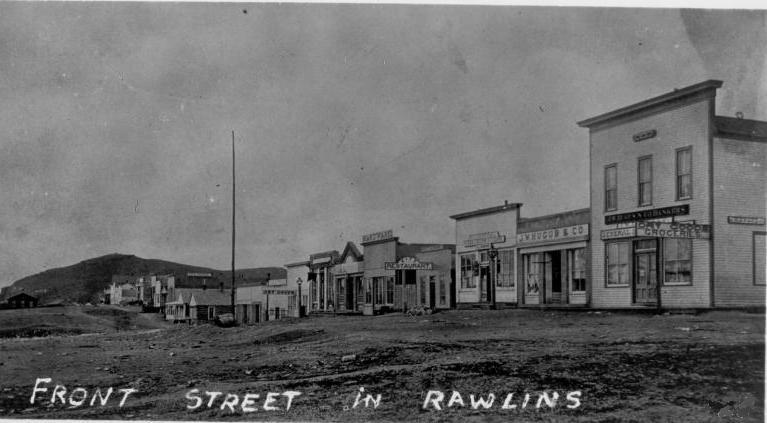 Front Street, Rawlins, 1870's
Front Street, Rawlins, 1870's
Rawlins, originally Rawlins Springs, was founded in 1868 with the arrival of
the Railroad and named after Gen. John A. Rawlins, who visited the
area on a tour of the west in 1867. See next photo. Within two years it had attained a
population of 574 including 81 members of the military assigned to Fort Rawlins. It was
incorporated as a municipality in 1886. Carbon County, itself, predates the
formation of Wyoming Territory and was created by the Dakota Legislature and included
present day Natrona and Johnson Counties.
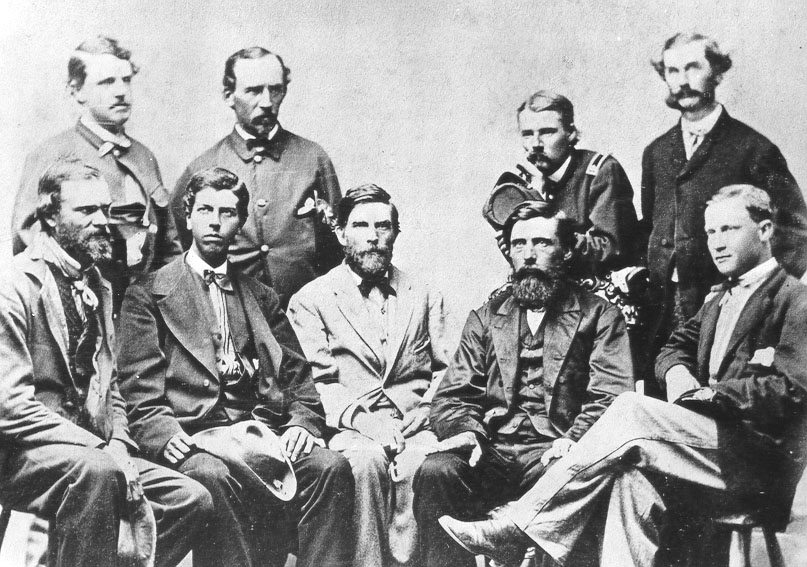
Rawlins Party, 1867: Back row - Left to Right: Lt. J. W. Wheelan, Lt. Col. J. K. Mizner,
Commanding Escort; Dr. Henry C. Terry, Asst. Surgeon; John E. Corwith,
Galena, Ill. Front Row: David Van Lennep, Geologist; John R. Duff, Mass.,
Gen. G. M. Dodge, Chief Engineer UPRR; Brig. Gen. John A. Rawlins, Chief of Staff;
Major W. Mck. Dunn, Aide de Camp to General Rawlins.
The Rawlins party was escorted by
two companies of cavalry and two companies of infantry under the command of Lt. Col. J. K. Mizner.
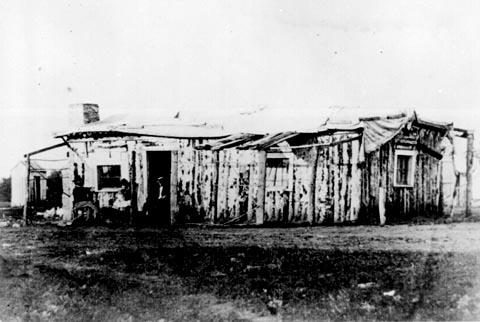
Officers' Quarters, Ft. Rawlings, 1877
Rawlins, Wyoming is named after John A. Rawlins, 1865 Brady Studios photo below.
Rawlins had worked in U.S.
Grant's father's store in Gelena, Ill. He was born in Galena in 1831. His father
abandoned the family to go to California for the 1849 Gold rush.
Rawlins was admitted to the bar in 1854 and became Gelena City Attorney in 1857.
Although he was a "Douglas Democrat" he received a number of promotions during
the Civil War while serving under General Grant.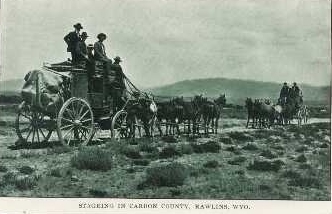 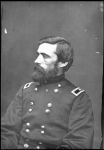 In 1861, Rawlings was diagnosed with consumption. Following the
war he took a trip to Wyoming for his health and allegedly indicated that
the highest honor he could receive would be to have the spring at what is now
Rawlins named for him. Following Grant's election he was appointed Secretary of War,
but died only five months into his term. Liberty Ship number 0434 was named after him. In 1861, Rawlings was diagnosed with consumption. Following the
war he took a trip to Wyoming for his health and allegedly indicated that
the highest honor he could receive would be to have the spring at what is now
Rawlins named for him. Following Grant's election he was appointed Secretary of War,
but died only five months into his term. Liberty Ship number 0434 was named after him.
Amongst the officers stationed at Ft. Rawlins was Arthur MacArthur, father of
Gen. Douglas MacArthur. Arthur MacArthur was transferred to Ft. Rawlins in Sept.
1869 from a recuitment center in the Harlem in New York. Commamding officer at the
time was Col. Philippe Regis de Trobriand, who during the Civil War had been
a brevet major general and whose father had been a general de brigade
in Bonaparte's Grande Armee.
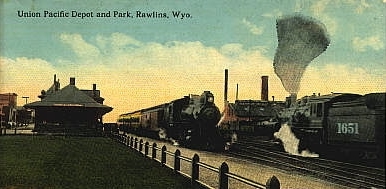 Rawlins Depot, right
Rawlins Depot, right
In the early days of Wyoming, all business transactions were done in cash. Thus,
as an example all payrolls for the Railroad were carried in cash. Bullion from the San Francisco
mint would be carried in a safe in the mail car. This, unfortunately, as in the
instance of the stages on the Deadwood Stage road, made tempting targets. One of the
more bizarre episodes in Wyoming History related to the attempted robbery of the
No. 3 Westbound train near Carbon by "Dutch Charley" and "Big Nose George Parrott." The robbery was unsuccessful, however,
one railroad employee was killed. Ultimately, Dutch Charley was captured but was removed by residents of Carbon from the
train on which he was being taken to Rawlins for trial. At the hanging the widow of the
railroad employee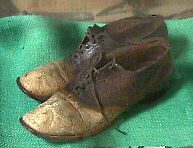 kicked the barrel out from under Dutch Charley to finish Charley's
career. kicked the barrel out from under Dutch Charley to finish Charley's
career. About two years later Big Nose was captured in Montana and was
returned to Rawlins for trial. He managed to escape but once on the street was recognized due to the
size of his proboscis. The citizenry of Rawlins left nothing to chance and promptly
held a festivity for Big Nose at the corner of Front and Third Streets.
The first effort using a barrel was unsucessful. On the second attempt Big Nose was made to ascend
a ladder leaning against a telegraph pole to which the rope was tied.
When the ladder was pulled out from under him, Big Nose managed to get his hands
free and cling to the pole where he begged for some one to take mercy and shoot him. No one did and
Big Nose tired, let go and strangled to death.
Following the execution, local physicians, John E. Osborne, Thomas Maghee, and Lillian Nelson, the first woman
physician in Wyoming, conducted an autopsy for the purpose of determining whether there
were any visible criminal abnormalities in Big Nose's brain. In examining the brain it was necessary to cut
off the skull cap which Dr. Nelson later used as an ashtray and doorstop before it found repose in
the Union Pacific Museum in Omaha. Dr. Osborne had Big Nose's hide tanned and made into
a medical bag and a pair of shoes, photo above left. The rest of Big Nose's remains were kept in a whiskey
barrel which after several years was buried near Dr. Osborne's medical office
in Rawlins.
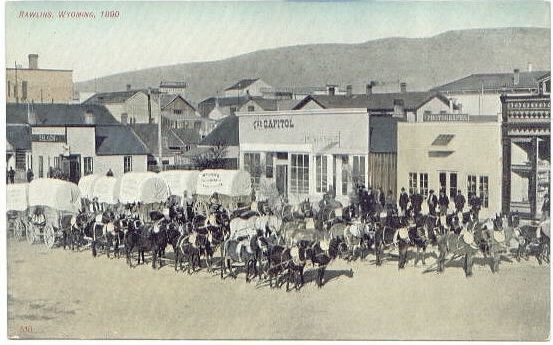
Mule trains, Rawlins, departing for Ft. Washakie and Lander, 1890
On the left, the one story building is Dr. Osborne's medical office and drug store. Next to the Capitol is
the Bon Ton Saloon and to the right is a photography studio. The advantage of mule trains over
ox drawn wagon trains was speed; that is while mule trains could not pull the loads of ox drawn trains they were much
faster in speed. A mule train could overtake and pass ox trains.
In 1892, Osborne was elected as Wyoming's first Democratic state governor. His election was probably more prompted
by the panic of 1892 rather than his actions with regard to Big Nose. In the
panic of 1892 many mining interests went broke. Allegedly,
Gov. Osborne wore the shoes to the inaugural ceremony. In the 1950's a barrel was discovered in Rawlins containing
human remains. A brief reunion of the skull cap with the remainder of the skull
demonstrated that the remains were that of Big Nose. The skull cap was returned to the UP museum,
the shoes are in the Carbon County Museum in Rawlins, and the medical bag has been lost. In addition to
being governor, Dr. Osborne was also one of the largest sheepherders in the state.
Rawlins photos continued on the next page.
|